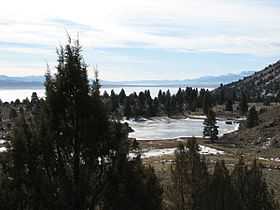Fandango Pass
| Fandango Pass | |
|---|---|
|
East side of Fandango Pass above Surprise Valley | |
| Elevation | 6,135 ft (1,870 m) |
| Traversed by | Modoc County Road 9 |
| Location |
Modoc National Forest, Modoc County, California, United States |
| Range | Warner Mountains |
| Coordinates | 41°48′08″N 120°12′25″W / 41.8021136°N 120.206895°WCoordinates: 41°48′08″N 120°12′25″W / 41.8021136°N 120.206895°W |
 Location in California | |
| Official name | Applegate-Lassen Emigrant Trail (Fandango Pass) |
| Designated | July 15, 1956 |
| Reference no. | 546[1] |
The Fandango Pass (previously Lassen Pass; variants Lassen Cut-off, Lassen Horn)[2] is a gap in the Warner Mountains of Modoc County, California, USA. Located in the Modoc National Forest, its elevation is 6,135 feet (1,870 m) above sea level.[2] It is approximately 5 mi (8.0 km) southwest of Fort Bidwell.[3]
Fandango Pass was historically notable for its location as the convergence of two trails, the Applegate and the Lassen, that were traveled by emigrant pioneers between 1846 and 1850.[1] The pass can now be traversed on a 10 mi (16 km) section of graded gravel, 1.5 lanes wide. It is closed during winter storms.[4]
History
The mountain pass was located at a convergence of two trails, the Applegate and the Lassen, that were traveled by emigrant pioneers between 1846 and 1850.[1] The Applegate Trail, originally intended as a less dangerous route to the Oregon Territory, was established in 1846 by the Applegate brothers and Levi Scott,[5] and ran through today's U.S. states of Idaho, Nevada, California, and Oregon. The Lassen Horn Trail[6] was established by Peter Lassen two years later and ran south at Goose Lake towards California Gold Rush mines and settlements.[7] Though the pass was extensively traversed from 1848 until 1853, its importance declined after 1869 with the opening of the Cedar Pass wagon road.[6]
To reach the pass, the emigrants had to cross or bypass Upper Alkali Lake in order to reach the Warner Mountains which is located to the west of the lake.[8] The historic cutoff, part of the California Trail, required passing through Rabbithole Springs, crossing the Black Rock Desert and High Rock Canyon before finally arriving at Surprise Valley, a journey of approximately 100 miles (160 km) of desert travel. From here, the trail climbs steeply to reach the pass, gaining about 1,600 ft (490 m) in about 2 mi (3.2 km).[8] From the summit, the trail descended steeply into the southeast end of Fandango Valley[3] by Goose Lake on the Oregon-California border. The Fandango Pass trail section is visible on the eastern side of the summit.[9]
Name
The pass, known initially as Lassen's Pass (1857 map) or Lassen Pass (1864 map),[3] was named for Lassen by gold seekers in 1849 who followed the route made by Lassen the previous year.[3]
One theory of the name change, from Lassen to Fandango, is that in the 1850s, an American Indian massacre may have occurred in the area. The massacre involved a large emigrant train that had camped at the edge of the valley. While the party indulged in a fandango after finding game, grass, and water,[10] it was attacked by Indians. Another theory suggests that Wolverine Rangers camping in the valley found it to be so cold that they burned their wagons for heat and danced a fandango. They named their camp site "Fandango Valley". Later pioneers who passed the area and saw burned wagons deduced that an Indian massacre had occurred.[11]
While the valley, peak and pass were named Fandango in the 1870s, a 1949 map, nonetheless, showed the pass as being named Lassen Horn.[3]
Landmark
On July 15, 1956, the Fandango Pass section of the Applegate-Lassen Emigrant Trail became California Historical Landmark No. 546. The plaque marker is located 10.8 mi (17.4 km) east of Highway 395 on Fandango Pass Road (County Road 9).[1] A second marker is located off the road, placed by Trails West.[8]
References
- ↑ 1.0 1.1 1.2 1.3 "Applegate-Lassen Emigrant Trail (Fandango Pass)". Office of Historic Preservation, California State Parks. Retrieved 2012-10-10.
- ↑ 2.0 2.1 U.S. Geological Survey Geographic Names Information System: Fandango Pass
- ↑ 3.0 3.1 3.2 3.3 3.4 Durham, David L. (1998). California's geographic names: a gazetteer of historic and modern names of the state. Quill Driver Books. p. 376. ISBN 1-884995-14-4.
- ↑ Green, Stewart M. (2004). Scenic Driving California (2 ed.). Globe Pequot. p. 71. ISBN 0-7627-3481-7.
- ↑ "California National Historic Trail - Fandango Pass". U.S. Department of the Interior, Bureau of Land Management. Retrieved 8 August 2010.
- ↑ 6.0 6.1 "The Applegate-Lassen Trail". hmdb.org. Retrieved 8 August 2010.
- ↑ "Warner Mountain issue". The Journal of the Modoc County Historical Society. 1991.
- ↑ 8.0 8.1 8.2 "THE APPLEGATE TRAIL, A VIRTUAL TOUR, CONTINUED". emigranttrailswest.org. Retrieved 8 August 2010.
- ↑ "Point of Interest - Applegate-Lassen Trail - Fandango Pass Section". fs.fed.us. Retrieved 8 August 2010.
- ↑ Wilkerson, Lyn (2003). American Trails Revisited: Following in the Footsteps of the Western Pioneers. iUniverse. p. 227. ISBN 0-595-28262-8.
- ↑ Abeloe, William N. (1966). Historic Spots in California, Third Edition. Hoover (3 ed.). Stanford University Press. p. 208. ISBN 0-8047-4020-8.
